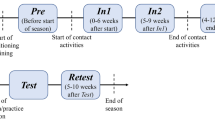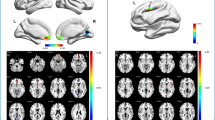Abstract
Purpose
To explore the effects of combat sports on functional network connectivity (FNC) in healthy adolescents.
Methods
Resting-state fMRI data were acquired from the combat sports (CS) group (n = 32) and non-athlete healthy control (HC) group (n = 29). Resting-state networks (RSNs) were obtained based on independent component analysis (ICA), and FNC analysis was performed. Then, the intra-network and inter-network connections were compared between the two groups.
Results
Compared with the HC group, the CS group demonstrated increased intra-network FC within the sensorimotor network (SMN), visual network (VIN), and cerebellum network (P < 0.01, FDR correction). Besides, decreased inter-network FC was found in the SMN-VIN, SMN-auditory network, SMN-default mode network, attention network (AN)-VIN, and AN-executive control network connections (P < 0.01, FDR correction).
Conclusion
This study showed a complex relationship between combat sports and FNC in adolescents. The observed FNC patterns in the CS group may reflect training-related brain network optimization, early signs of subclinical brain damage, or preexisting differences. The extensive effects of combat sports on FNC in adolescents could expand our understanding of neuromodulatory mechanisms.



Similar content being viewed by others
References
Voss MW, Erickson KI, Prakash RS et al (2013) Neurobiological markers of exercise-related brain plasticity in older adults. Brain Behav Immun 28:90–99
Colcombe SJ, Erickson KI, Scalf PE et al (2006) Aerobic exercise training increases brain volume in aging humans. J Gerontol A Biol 61:1166–1170
Colcombe SJ, Kramer AF, Erickson KI et al (2004) Cardiovascular fitness, cortical plasticity, and aging. Proc Natl Acad Sci US 101:3316–3321
Erickson KI, Hillman CH, Kramer AF (2015) Physical activity, brain, and cognition. Curr Opin Behav Sci 4:27–32
Knaepen K, Goekint M, Heyman EM et al (2010) Neuroplasticity exercise-induced response of peripheral brain-derived neurotrophic factor: a systematic review of experimental studies in human subjects. Sports Med 40:765–801
Kirkwood MW, Yeates KO, Wilson PE (2006) Pediatric sport-related concussion: a review of the clinical management of an often neglected population. Pediatrics 117:1359–1371
Hillman CH, Erickson KI, Kramer AF (2008) Be smart, exercise your heart: exercise effects on brain and cognition. Nat Rev Neurosci 9:58–65
Jafri MJ, Pearlson GD, Stevens M et al (2008) A method for functional network connectivity among spatially independent resting-state components in schizophrenia. Neuroimage 39:1666–1681
Gunnell KE, Poitras VJ, LeBlanc A et al (2019) Physical activity and brain structure, brain function, and cognition in children and youth: a systematic review of randomized controlled trials. Ment Health Phys Act 16:105–127
An L, Cao QJ, Sui MQ et al (2013) Local synchronization and amplitude of the fluctuation of spontaneous brain activity in attention-deficit/hyperactivity disorder: a resting-state fMRI study. Neurosci Bull 29:603–613
Ma WY, Yao Q, Hu GJ et al (2019) Dysfunctional dynamics of intra- and inter-network connectivity in dementia with Lewy bodies. Front Neurol 10:1–10
Zhan Y, Ma J, Alexander-Bloch AF et al (2016) Longitudinal study of impaired intra- and inter-network brain connectivity in subjects at high risk for Alzheimer’s disease. J Alzheimer’s Dis 52:913–927
Shirer W, Ryali S, Rykhlevskaia E et al (2012) Decoding subject-driven cognitive states with whole-brain connectivity patterns. Cereb Cortex 22:158–165
Allen EA, Erhardt EB, Damaraju E et al (2011) A baseline for the multivariate comparison of resting-state networks. Front Syst Neurosci 5:1–23
Luo C, Li Q, Lai Y et al (2011) Altered functional connectivity in default mode network in absence epilepsy: a resting-state fMRI study. Hum Brain Mapp 32:438–449
Calhoun VD, Adali T, Pearlson GD et al (2001) A method for making group inferences from functional MRI data using independent component analysis. Hum Brain Mapp 14:140–151
Chaddock-Heyman L, Erickson KI, Voss MW et al (2013) The effects of physical activity on functional MRI activation associated with cognitive control in children: a randomized controlled intervention. Front Hum Neurosci 7:72
Herting MM, Nagel BJ (2013) Differences in brain activity during a verbal associative memory encoding task in high- and low-fit adolescents. Cogn Neurosci 25:595–612
Voss MW, Chaddock L, Kim JS et al (2011) Aerobic fitness is associated with greater efficiency of the network underlying cognitive control in preadolescent children. Neuroscience 199:166–176
McAllister TW, Ford JC, Flashman LA et al (2014) Effect of head impacts on diffusivity measures in a cohort of collegiate contact sport athletes. Neurology 82:63–69
Janssen I, Leblanc AG (2010) Systematic review of the health benefits of physical activity and fitness in school-aged children and youth. Int J Behav Nutr Phys Act 7:40
Patel R, Spreng RN, Turner GR (2013) Functional brain changes following cognitive and motor skills training: a quantitative meta-analysis. Neurorehabil Neural Repair 27:187–199
Wang J, Lu M, Fan Y, Wen X et al (2016) Exploring brain functional plasticity in world class gymnasts: a network analysis. Brain Struct Funct 221:3503–3519
Rizzolatti G, Luppino G (2001) The cortical motor system. Neuron 31:889–901
Wu T, Kansaku K, Hallett M (2004) How self-initiated memorized movements become automatic: a functional MRI study. J Neurophysiol 91:1690–1698
Chaddock L, Erickson KI, Prakash RS et al (2012) A functional MRI investigation of the association between childhood aerobic fitness and neurocognitive control. Biol Psychol 89:260–268
Strotzer QD, Anthofer JM, Faltermeier R et al (2019) Deep brain stimulation: connectivity profile for bradykinesia alleviation. Ann Neurol 85:852–864
Dumith SC, Gigante DP, Domingues MR et al (2011) Physical activity change during adolescence: a systematic review and a pooled analysis. Int J Epidemiol 40:685–698
Huang H, Wang J, Seger C et al (2018) Long-term intensive gymnastic training induced changes in intra- and inter-network functional connectivity: an independent component analysis Brain. Struct Funct 223:131–144
Lewis CM, Baldassarre A, Committeri G et al (2009) Learning sculpts the spontaneous activity of the resting human brain. Proc Natl Acad Sci USA 106:17558–17563
Fox MD, Snyder AZ, Vincent JL et al (2005) The human brain is intrinsically organized into dynamic, anticorrelated functional networks. Proc Natl Acad Sci USA 102:9673–9678
Lebel C, Walker L, Leemans A et al (2008) Microstructural maturation of the human brain from childhood to adulthood. Neuroimage 40:1044–1055
Gusnard DA, Raichle ME (2001) Searching for a baseline: functional imaging and the resting human brain. Nat Rev Neurosci 2:685–694
Weiner KS, Grill-Spector K (2013) Neural representations of faces and limbs neighbor in human high-level visual cortex: evidence for a new organization principle. Psychol Res 77:74–97
Nielsen JB, Cohen LG (2008) The Olympic brain. Does corticospinal plasticity play a role in acquisition of skills required for high performance sports? J Physiol 586:65–70
Corbetta M, Shulman GL (2002) Control of goal-directed and stimulus-driven attention in the brain. Nat Rev Neurosci 3:201–215
Zanto TP, Gazzaley A (2013) Fronto-parietal network: flexible hub of cognitive control. Trends Cogn Sci 17:602–603
Li F, Lu L, Shang S et al (2020) Disrupted functional network connectivity predicts cognitive impairment after acute mild traumatic brain injury. CNS Neurosci Ther 26:1083–1091
Nathan DE, Oakes TR, Yeh PH et al (2015) Exploring variations in functional connectivity of the resting state default mode network in mild traumatic brain injury. Brain Connect 5:102–114
Palacios EM, Sala-Llonch R, Junque C et al (2013) Resting-state functional magnetic resonance imaging activity and connectivity and cognitive outcome in traumatic brain injury. JAMA Neurol 70:845–851
Martini D, Eckner J, Kutcher J et al (2013) Subconcussive head impact biomechanics: comparing differing offensive schemes. Med Sci Sports Exerc 45:755–761
Broglio SP, Eckner JT, Martini D et al (2011) Cumulative head impact burden in high school football. Neurotrauma 28:2069–2078
Zhou Y, Lui YW, Zuo XN et al (2014) Characterization of thalamo-cortical association using amplitude and connectivity of functional MRI in mild traumatic brain injury. J Magn Reson Imaging 39:1558–1568
McCuen E, Svaldi D, Breedlove K et al (2015) Collegiate women’s soccer players suffer greater cumulative head impacts than their high school counterparts. J Biomech 48:3729–3732
Author information
Authors and Affiliations
Corresponding author
Ethics declarations
Conflict of interest
The authors declare that they have no conflict of interest.
Ethical approval
All procedures performed in the studies involving human participants were in accordance with the ethical standards of the institutional and/or national research committee and with the 1964 Helsinki Declaration and its later amendments or comparable ethical standards.
Informed consent
Informed consent was obtained from the legal guardians of all individual participants included in the study.
Additional information
Publisher’s note
Springer Nature remains neutral with regard to jurisdictional claims in published maps and institutional affiliations.
Rights and permissions
About this article
Cite this article
Li, W., Kong, X., Zhanng, Y. et al. Effects of combat sports on functional network connectivity in adolescents. Neuroradiology 63, 1863–1871 (2021). https://doi.org/10.1007/s00234-021-02713-y
Received:
Accepted:
Published:
Issue Date:
DOI: https://doi.org/10.1007/s00234-021-02713-y




